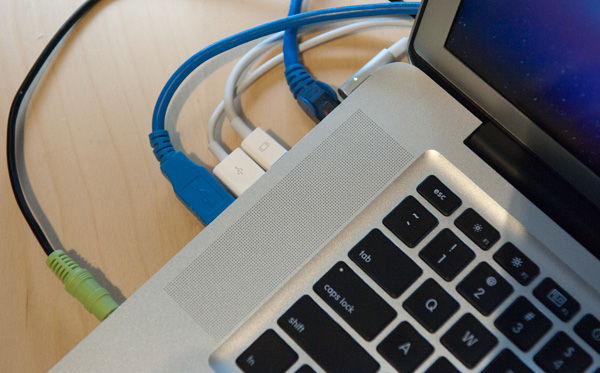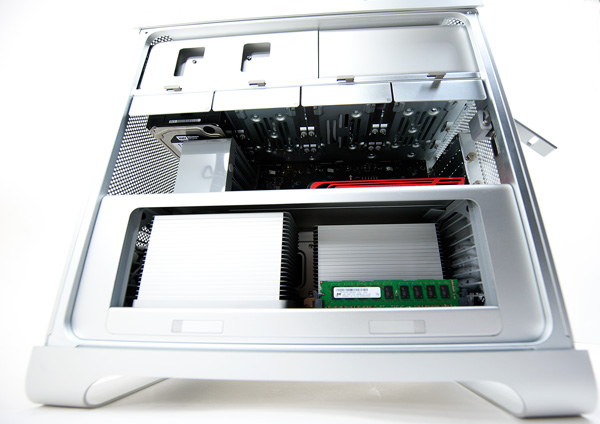The MacBook Pro Review (13 & 15-inch): 2011 Brings Sandy Bridge
by Anand Lal Shimpi, Brian Klug & Vivek Gowri on March 10, 2011 4:17 PM EST- Posted in
- Laptops
- Mac
- Apple
- Intel
- MacBook Pro
- Sandy Bridge
The Big Picture
For years Intel has been telling me that the world is becoming more mobile. Yet I could never bring myself to replace my desktop with a notebook, despite the convenience. I was always a two-machine-man. I had my desktop at home and my notebook that I carried around with me to tradeshows and meetings. I eventually added more mobile devices to my collection: an ultraportable for when I need to write but don't need to edit/publish, a smartphone and a tablet. Admittedly the tablet gets the least amount of use of my computing devices, I mostly just have it because I sort of have to. Although my collection of computing devices has become more mobile, none of these devices has supplanted the need for a desktop in my life.
Last year when the Arrandale based MacBook Pros came out I decided to give the notebook as a desktop thing a try. The benefits were obvious. I would always have everything with me whenever I carried around my notebook. I wouldn't have to worry about keeping documents in sync between two machines. And I'd see a significant reduction in power consumption and heat output. I setup an external storage array for my photos, music and movies, and then moved my main drive image over to the 2010 15-inch MacBook Pro. I even made sure I had the fastest 2.66GHz Core i7 available at my disposal. Sure it wasn't an 8-core Nehalem setup, but maybe it wouldn't be that noticeable?
I lasted less than a day.
It wasn't so much that I needed an 8-core Xeon setup. I spend less than 10% of my time running applications that require all 8 cores/16 threads. No, the issue was that Arrandale's two cores just weren't enough.
Most of my workload isn't heavily threaded, but the issue with only having two cores is that if you are running one processor intensive task you're limited in what else you can do with your system. Run a heavily threaded application and you've got no CPU time left for anything else. Run a lightly threaded application that's CPU intensive and you still only have one remaining core to deal with everything else. I don't need 8 cores all of the time, but I need more than two.
I suspect I'm not the only user around who may not constantly run heavily threaded apps, but can definitely feel the difference between two and four cores. I'll also go out on a limb and say the number of users who can tell the difference between 2 and 4 cores is larger than the number of users who can tell the difference between 4 and 8. What I'm getting at is this: Apple outfitting the new 15-inch MacBook Pro with a quad-core processor is a deliberate attempt by Cupertino to bring mobility to more of its desktop users.
Apple doesn't offer a good desktop Mac. You can get the Mac Pro but it's quite expensive and is often times overkill if you don't have a heavy content creation workload. Then there's the iMac, which can hit the sweet spot of the performance curve but there's no way to get it without a massive integrated display. Truth be told, Apple's 27-inch iMac is actually a bargain (for a Mac) considering you get a quad-core Lynnfield with a pretty good $999 display all for $1999. However not everyone is sold on the all-in-one form factor.
The new 15-inch MacBook Pro, when paired with an SSD, gives desktop users another alternative. Bring your external display to the party but drive it off of a notebook. You'll sacrifice GPU performance of course, but if you aren't a heavy gamer then you're not giving up all that much. In fact, for normal workloads you'd be hard pressed to tell the difference between one of these new MBPs and an iMac or Mac Pro.
Ultimately I believe this is why Apple chose to make the move to quad-core alongside Thunderbolt enablement. The main reason to stick four cores in a 15-inch chassis is for desktop replacement workloads. The last remaining limitation for desktop users adoption a notebook? Expansion.
The Mac Pro has four 3.5" drive bays. The 15-inch MacBook Pro, on a good day, has two 2.5" drive bays and that's only if you ditch the optical drive and buy an optibay. Then there's the whole fact that you can't add anything that's not a USB or FireWire device. Where are the PCIe slots? What about GPU upgrades? Currently you can't do any of that on a 15-inch MacBook Pro.
Thunderbolt could enable external expansion boxes. Not just for storage but other PCIe add-in cards. The bandwidth offered by a single Thunderbolt channel isn't really enough for high end GPUs, but a faster link could change the way switchable graphics works in the future.
My Concerns
Ever since the new MacBook Pros have arrived I've powered down the Mac Pro and have been using the 15-inch 2.3GHz quad-core as my desktop replacement. When at my desk it's connected directly to my monitor, keyboard, mouse, speakers and other peripherals. It's my desktop. But when I leave my desk, I unplug the five cables I've got going to the MBP (power, DisplayPort, 2xUSB, 1/8" audio and Ethernet) and carry my "desktop" with me.
The convenience is nice, I will admit. Before the mobile-as-a-desktop switch I always had to prepare my notebook with the data I needed for whatever trip I was taking. That usually included the latest copy of my Bench databases, snippets of articles I was writing and other pertinent documents. I don't rely on any cloud syncing for my most sensitive information, I did it all manually. With my laptop being my desktop (and vice versa), I lose the need to manually sync content across those two devices. All of my windows are in the same place all the time and life is good.
The performance difference in my day to day work isn't noticeable. Everything seems just as fast. If Quick Sync were enabled I'm pretty sure I'd be happy with the overall level of performance from this machine vs. a beefier Mac Pro setup. The number of times I need more than 4 cores for something other than video transcoding are pretty limited. I'm not saying that's the case for everyone, it's just the case for me personally.
There are downsides however.
Security. In the past, if I lost my notebook I only lost a minimal amount of data. I typically only put whatever I needed for my trip on my notebook, everything else was at home on my desktop. Now if I lose my notebook, tons of data goes with it—including lots of NDA data. FileVault (OS X's built in home folder encryption) is an obvious solution, but it doesn't come without issues. With FileVault enabled Time Machine backups can only happen when you're logged out and seem to take forever.
I believe OS X 10.7 is better equipped to handle security for a mobile desktop usage model. You get full drive encryption (FileVault only does your home folder) and perhaps even a Find my Mac feature.
Noise. In a desktop, when you've got a high workload on one or more cores your fans may spin a little faster but it's hardly noticeable. The heatsink you have cooling your CPU has a lot of surface area and the fan attached to it is large and spins slowly. With a notebook you don't have the luxury of quickly dissipating heat. As a result, when I have too many browser windows open with Flash running or if the dGPU is doing anything in 3D, the CPU/GPU fans in the 15-inch MBP spin up and are loud. Under these circumstances the setup is louder than my desktop which is annoying.
Cables. Ideally I'd want no cables connecting my notebook to all of the peripherals I need to connect it to. I want to sit it down and have everything just work wirelessly. I'd also want wireless power and a bunch of things that aren't realistic today. So I'm willing to deal with some cabling inconvenience. My preference would be two cables: one for power and one for peripherals/display. Today, it's five.

I believe this is another potential use for Thunderbolt down the road. Apple could build a Cinema Display with Ethernet, more USB ports, FireWire and audio out integrated into the display itself. A single Thunderbolt cable would carry all of those interfaces, reducing my current cable clutter to just two cables.
All of these are solvable problems, but they are definite issues today. Personally I don't believe they are enough to make me switch back to a desktop for work, although the security thing still bothers me. I may end up segmenting my data into stuff I keep on locally attached storage vs. on my notebook's internal drive in order to minimize what I carry around with me when I'm traveling. As for FileVault, I may look into alternative encryption options as Apple's solution right now just isn't practical if you use Time Machine.











198 Comments
View All Comments
tipoo - Thursday, March 10, 2011 - link
Its a shame that their base 15 inch, a 2000 dollar laptop, has a 256MB card by default. Even for non-gamers, that's starting to become a bottleneck. Especailly as this "pro" machine will make it into the hands of creative professionals, doing video work, rendering, mudbox, etc.Interesting about the performance differences in the HD3000 and 320M under Windows vs OSX.
tipoo - Thursday, March 10, 2011 - link
p.s whats an SNB GPU? Is that a typo? SB, perhaps?Brian Klug - Thursday, March 10, 2011 - link
When we say that, we're just referring to the Sandy Bridge (SNB) GPU. Essentially it's shorthand for the Intel HD Graphics 3000.-Brian
IntelUser2000 - Thursday, March 10, 2011 - link
The official short form for Sandy Bridge is SNB, not SB. SB is South Bridge.dcollins - Thursday, March 10, 2011 - link
For some reason Sandy Bridge is alway abbreviated as SNB. It took me a while to figure out.KoolAidMan1 - Thursday, March 10, 2011 - link
The baseline 15" MBP is $1800, not $2000.In any case, it is an unusual update. Usually the performance delta between MBPs hasn't been so extreme. The last generation had a common GPU between all 15" models, the main difference being video RAM. Now they have completely different GPUs, one being REALLY fast and the other not much better than the one that was in the models from last year.
saleem.kh - Sunday, March 13, 2011 - link
Dear, please consider approximately 9.5% US Sales Tax on $1,799. Then total price reaches to $2,000 approxPeteH - Monday, March 14, 2011 - link
There is no such thing as US Sales Tax, only state and local sales taxes. State rates range from a low of 0% to a high of 8.25% (I don't happen to know the range of local sales taxes). Adding 9.5% to the price of a computer seems completely arbitrary.turtle44 - Thursday, June 2, 2011 - link
sales tax in NY,NY is 11% don't say what you don't know.sfdiesel - Monday, July 25, 2011 - link
Sales tax in Portland, OR is 0%. So, adding 9.5% to the price of a computer does seem completely arbitrary.Do say what you don't know.